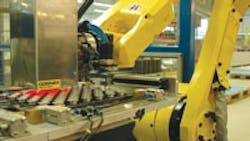The human eye possesses 130 million light-sensitive rods and cones that convert light into chemical impulses, which travel at a rate of a billion signals per second to the brain.
Yet for all its complexity and acuity, the human eye is highly unreliable -- especially when it comes to repetitive work, such as counting the number of sesame seeds on a hamburger bun for hours at a time.
Those tasks have instead been handed over to robot and vision systems, which have grown more sophisticated, easier to use and more affordable, reaching a broader range of operations.
Vision-guided systems are not a new technology. Machine vision first appeared in the early stages of computer development in the late 1950s and 1960s, as researchers at the Massachusetts Institute of Technology, Carnegie Mellon University and Stanford University focused on the idea of artificial intelligence -- somehow using a computer to visualize and interact with its environment. Their first widespread application came 25 years ago in the semiconductor industry.
What's changing now, says Jon Keating, product marketing manager at Cognex, a manufacturer of vision systems, is their expanded use in factory automation.
"It really wasn't the technology that was limiting [vision-guided systems] early on, it was the integration," says Keating. "The intercommunication between the robot and the vision system has improved dramatically."
Cognex's In-Sight 5000 Series is mounted in a fixed position, used to accurately locate wheel hubs in an automotive application.
Robots can determine where an image was taken, so they can identify where an object is sitting and then make judgments about its size, type and quality compliance.
They also can change the program based on the images and algorithms. For example, parts of different sizes may take different paths. And, Part A can be dropped off at the location where Part B should be dropped off.
For years, vision systems required a dedicated system that used a separate computer and often required human supervision. Today, they are self-contained units, designed for flexibility.
"That's the same overall trend we're seeing in robotics in general," says Bob Hirschinger, product marketing manager for Logix Motion at Rockwell Automation.
Hirschinger believes that the integration of vision systems mirrors that of robot systems with general line controllers. "You're seeing CAD robot controllers in some cases eliminated, and the vision system and control of the robot is integrated directly into the main line controller," he says.
That trend has led to easier integration, faster line speed and a more simplified validation process in industries such as packaging or assembly.
Cognex's In-Sight Micro is used to accurately guide the robot to an automotive part, then provide inspection.
"We're trying to lower the complexity of the systems so you don't have to be a Ph.D. to run it," says Kevin Taylor, ISRA Vision Systems' vice president of the automotive business unit for North America. "They are getting more simplified, so an average guy can program it in a factory."
Taylor compares these advances to what consumers have seen in electronics overall. Televisions and laptop computers have gotten lighter in terms of weight and price. The same is true in vision systems.
Cognex's Keating believes much of that comes from technologies such as Power over Ethernet (PoE), which describes a system that transfers power and data to remote devices over a network.
"There is a move toward even smaller vision systems," says Keating. "PoE has been able to reduce the number of cables to one on a very small vision system. It's made the weight requirement and cable easier to meet. And I think you'll see more PoE cameras on the market in the next few years."
Rockwell Automation's Hirschinger says the growth in robots and vision systems -- and their subsequent affordability and adaptability -- is leading to a wider range of applications.
"You're seeing it combine inspection and placement," says Hirschinger. "That can apply to any number of industries and tasks."
And perform those tasks more predictably and efficiently than the brilliant human eye.
See Also
